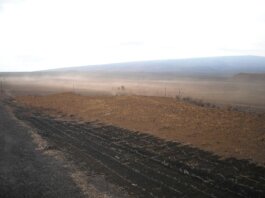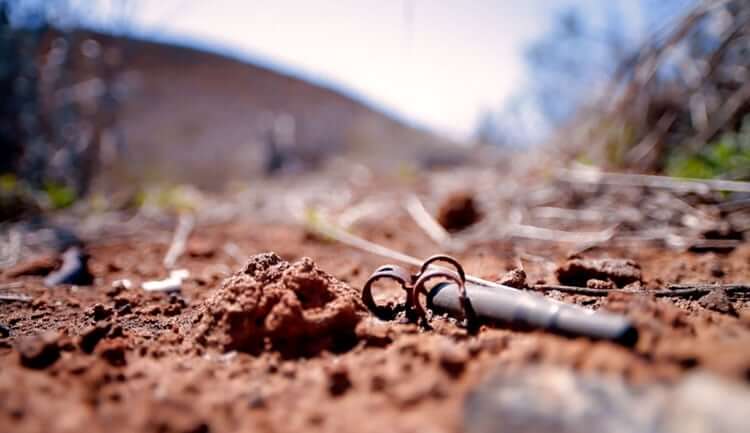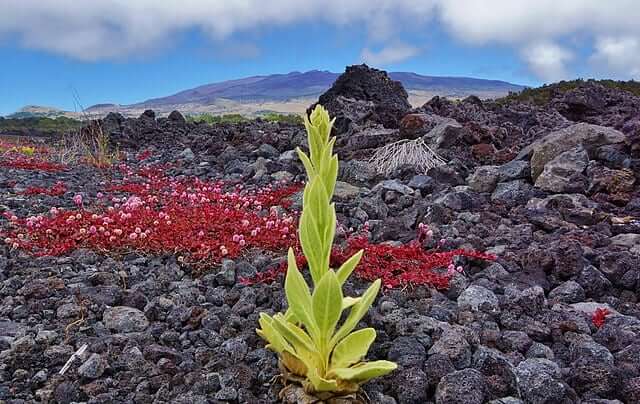Pōhakuloa, Hawaii: A Land Besieged
ASIA--PACIFIC, 2 Sep 2024
Puanani Fernandez-Akamine | Ka Wai Ola - TRANSCEND Media Service

For 75 years, mostly hidden from sight, Pōhakuloa, a high plateau in the center of Moku o Keawe, has been used for military live-fire training. This has damaged the ʻāina (including the habitats of endangered species), contaminated the soil and imperiled the water table. In this photo, dust partially obscuring troop movement provides a visual metaphor of the problem. Photo: Bobby Camara
1 Sep 2024 – The wao akua (godly realm) of Pōhakuloa is a high plateau in the center of Moku o Keawe, Hawaii.
Created over millennia by ancient lava flows from Maunakea to its north, Maunaloa to its south and Hualālai to its west, at its lowest point Pōhakuloa sits at an elevation of 6,200 feet. It is a vast area encompassing more than 200 square miles of land.
Evidence of its volcanic origin is revealed in the windswept, desert landscape, especially in its westerly reaches, although there is the occasional kīpuka (oasis) hidden throughout. Pōhakuloa is home to many rare, native species of plants and animals, and it includes a portion of the last remaining sub-alpine tropical dryland ecosystem in the world. It is a conservation zone.
For centuries, Pōhakuloa was a place set aside; a realm of deities and elemental spirits. Although it might see corporeal travelers from time to time, there were no permanent settlements. Still, it is not devoid of human fingerprints. Sometime around the turn of the 16th century, celebrated aliʻi nui Umi-a-Liloa built a kuahu (altar) and watchtower in Pōhakuloa at the place known as Puʻu Keʻekeʻe.
There is an otherworldly aspect to Pōhakuloa. It is no wonder that many iwi kūpuna were laid to rest there.
It is therefore hurtful and an affront to many Kānaka ʻŌiwi that this sacred space has been defiled by 75 years of military training exercises.
The Need to Restore Pono

Pōhakuloa Training Area Map – PDF Format
E. Kalani Flores is a professor at Hawaiʻi Community College, a cultural practitioner, and long-time kiaʻi who has walked the lands of Pōhakuloa. He served for about 10 years on the U.S. Army’s Pōhakuloa Training Area (PTA) cultural advisory committee – until his activism earned him a premature dismissal from the group.
Years ago, during a site visit to Pōhakuloa with the cultural advisory committee, Flores became aware of a place called Puʻu Koli that straddles the eastern boundary between PTA and state lands. Flores immediately knew that Puʻu Koli was special. Atop the puʻu (hill) there was an ahu (shrine) and the opening of a lava tube that he likened to a woman’s womb.
“When you look at a map, this puʻu is actually the center of the island,” he said. “There are certain points that are what we call piko (centers). Puʻu Koli is the energetic piko of the island.”
Flores explained that this particular piko is a intersection of energy lines within the earth and that certain ancestors would walk these lines to keep them intact and maintain balance between the spiritual and physical realms.
He believes that there are areas throughout the pae ʻāina, and at certain cultural sites, where energy lines intersect. An example is Kūkaniloko on Oʻahu, the site of the famous birthing stones. It is also considered an energetic piko.
Flores uses acupuncture as an analogy to explain the concept. “Acupuncture works on the premise that the body has energy lines running through it. If an energy line is not flowing properly [causing pain or illness], the acupuncturist tries to restore it by focusing on certain energy points. We have energy lines that run through us. And so does the earth.”
Flores says that we can leave an imprint on the land whenever we interact with it. He refers to this as “human energetic energies” and says that those imprints can be positive, negative or neutral. Which is why restoring lōkahi (harmony) and pono (balance) to Pōhakuloa is so important. Military activity in that area has resulted in tremendous destruction and disturbance causing the natural elements to be out of balance.
“The military is creating and inflicting an energy of killing and war and everything associated with it at Pōhakuloa,” he said. “That is the energetic imprint that they’re leaving right in the center of our island.”
Depleted Uranium in the Soil

Long-time Hawaiʻi-based social justice and peace activist Jim Albertini has been an outspoken critic of the military’s misuse of Pōhakuloa for decades. According to Albertini, millions of live rounds are fired annually at PTA and he notes that, “B-52 and B-2 bombers fly non-stop missions to and from Louisiana, Missouri and Guam to drop bombs on Pōhakuloa.”
But beyond the damage that conventional weapons inflict upon the ʻāina, and the violence they represent, Albertini is particularly concerned about the presence of depleted uranium (DU) at Pōhakuloa.
In 2007, it was discovered that spotting rounds containing DU, a radioactive heavy metal, had been fired at Pōhakuloa in the 1960s for Davy Crockett nuclear weapon system training. According to the U.S. Army, the Davy Crockett is “a battalion-level nuclear-capable recoilless weapon” deployed between 1961-1971.
DU is what remains after uranium-235 is extracted from uranium that has been mined to make nuclear weapons and reactors. In addition to its use in spotting rounds, DU was later used to make other munitions, including armor-piercing missiles. It is highly explosive.
At a Hawaiʻi County Council meeting in 2008, U.S. Army Garrison Hawaiʻi Commander Col. Howard Killian confirmed that DU spotting rounds had been fired at Pōhakuloa.
“Col. Killian testified that, based on the number of people certified at PTA to fire the Davy Crockett nuclear weapon system, the number of DU spotting rounds fired at PTA during the 1960s was about 2,000,” said Albertini.
“He also said that DU weapons have been ‘banned in training since 1996,’ suggesting that other DU weapons have also been used at Pōhakuloa – so it is likely that there is much more DU there than what was used in the spotting rounds in the 1960s.”
When DU rounds explode, some of the uranium settles onto the ground and the rest becomes aerosolized, meaning it can be inhaled and carried on the winds. And the half-life of DU (meaning the time it takes for the DU to decrease to half of its initial value) is a staggering 4.5 billion years.
This means that when current live-fire exercises at Pōhakuloa disturb the soil, there is still radioactive DU in the resulting dust clouds that can be aerosolized and blown across the island.
Albertini explained that the DU radiation at PTA is made up primarily of alpha particles. Inhaled, they travel through the lymph system causing cancers and other diseases. It can also affect a person’s DNA and cause genetic damage that will be passed down to future generations.
To address the hazards of DU at PTA, Puna Council- woman Emily Naeʻole introduced Resolution 639-08 which the Hawaiʻi County Council passed in July 2008. It outlined an eight-point plan. Item number one: “Order a complete halt to B-2 bombing missions and to all live firing exercises and other activities at the Pōhakuloa Training Area that create dust until there is an assessment and clean up of the depleted uranium already present.”
But the county’s resolution was not acted upon by the U.S. military and live-fire exercises at Pōhakuloa continued unabated.
Our ʻĀina is Not For War Games
TO CONTINUE READING Go to Original – kawaiola.news
Tags: Anti-militarism, Asia and the Pacific, Hawaii, Pacific Islands, Pentagon, US Military
DISCLAIMER: The statements, views and opinions expressed in pieces republished here are solely those of the authors and do not necessarily represent those of TMS. In accordance with title 17 U.S.C. section 107, this material is distributed without profit to those who have expressed a prior interest in receiving the included information for research and educational purposes. TMS has no affiliation whatsoever with the originator of this article nor is TMS endorsed or sponsored by the originator. “GO TO ORIGINAL” links are provided as a convenience to our readers and allow for verification of authenticity. However, as originating pages are often updated by their originating host sites, the versions posted may not match the versions our readers view when clicking the “GO TO ORIGINAL” links. This site contains copyrighted material the use of which has not always been specifically authorized by the copyright owner. We are making such material available in our efforts to advance understanding of environmental, political, human rights, economic, democracy, scientific, and social justice issues, etc. We believe this constitutes a ‘fair use’ of any such copyrighted material as provided for in section 107 of the US Copyright Law. In accordance with Title 17 U.S.C. Section 107, the material on this site is distributed without profit to those who have expressed a prior interest in receiving the included information for research and educational purposes. For more information go to: http://www.law.cornell.edu/uscode/17/107.shtml. If you wish to use copyrighted material from this site for purposes of your own that go beyond ‘fair use’, you must obtain permission from the copyright owner.
Join the discussion!
We welcome debate and dissent, but personal — ad hominem — attacks (on authors, other users or any individual), abuse and defamatory language will not be tolerated. Nor will we tolerate attempts to deliberately disrupt discussions. We aim to maintain an inviting space to focus on intelligent interactions and debates.

